Feeding Our Furry Friends
INGREDIENTS
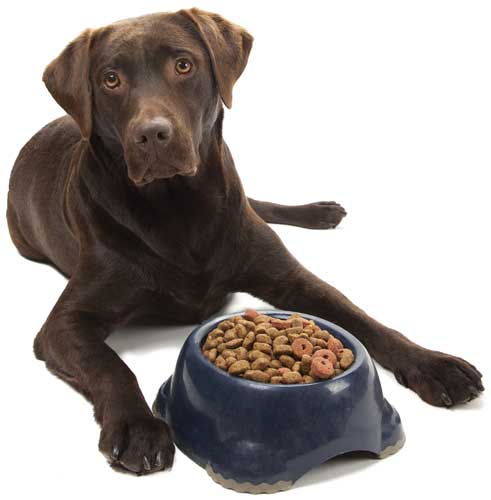 Walk down any pet food aisle and you are sure to spy packages with claims such as natural, free from, and healthy, or wording that calls out specific ingredients like protein, probiotics, and omega-3s. Cat and dog food products are more sophisticated than ever and reflect many of the trends that are seen in food products for humans. Foods that come in different flavors and textures, claim to help maintain active lifestyles, and address specific health needs—all of these products are available to feed pets thanks to ingredients used in human food. “Trends for more nutritionally functional ingredients are in part what started the superpremium pet food trend,” says Gary Lynch, senior project and account manager at Horn, La Mirada, Calif. (ethorn.com). Flax, fish oils, and algae ingredients add anti-inflammatory effects to pet foods while prebiotic fibers from MOS and FOS fibers and inulin, antioxidants from berries, tea, and botanicals, and healthy fats like medium-chain triglycerides are increasingly used, he says. This month’s Ingredients column takes a look at some key ingredients being used to make mealtime and treat time more tasty and nutritious for the two most popular pets in the United States, cats and dogs.
Walk down any pet food aisle and you are sure to spy packages with claims such as natural, free from, and healthy, or wording that calls out specific ingredients like protein, probiotics, and omega-3s. Cat and dog food products are more sophisticated than ever and reflect many of the trends that are seen in food products for humans. Foods that come in different flavors and textures, claim to help maintain active lifestyles, and address specific health needs—all of these products are available to feed pets thanks to ingredients used in human food. “Trends for more nutritionally functional ingredients are in part what started the superpremium pet food trend,” says Gary Lynch, senior project and account manager at Horn, La Mirada, Calif. (ethorn.com). Flax, fish oils, and algae ingredients add anti-inflammatory effects to pet foods while prebiotic fibers from MOS and FOS fibers and inulin, antioxidants from berries, tea, and botanicals, and healthy fats like medium-chain triglycerides are increasingly used, he says. This month’s Ingredients column takes a look at some key ingredients being used to make mealtime and treat time more tasty and nutritious for the two most popular pets in the United States, cats and dogs.
Protein from Plant, Dairy Sources
The role of protein in the diets of cats and dogs ranges from building muscle to maintaining healthy skin and hair to playing a role in hormone production. Common animal protein sources are beef, chicken, and fish. Others like lamb, pork, and even duck and turkey are used by some pet food manufacturers. Fromm Family Pet Food formulates its Fromm Four-Star Game Bird dog food with duck, turkey, quail, and pheasant and Fromm Four-Star Hasen Duckenpfeffer cat food with rabbit and duck.
While most of the protein used in cat and dog food comes from animal flesh and organs (cats are obligate carnivores while dogs can consume a more omnivorous diet), other sources derived from plants and dairy are used in addition to meat/poultry/fish in formulations for both nutritional and functional purposes.
Looking at plant proteins first, pulses have grown in popularity in the last three to five years, driven in part by consumers having a positive view of pulses, says Lynch. He adds that pea protein in particular is the pulse protein of choice to replace soy protein in many human protein health supplement applications. Pulse proteins also have a very good nutritional amino acid profile that complements animal protein sources making them an attractive protein in many pet food applications. The popularity of one application—grain-free pet food—contributes to the greater use of pulses like pea. Grain-free pet foods are formulated without any grains, including grain-derived protein ingredients like corn gluten meal, so Lynch says product developers turn to other sources. “Egg protein is an option, but plant-based products are usually more cost-effective. While potato protein is used in grain-free pet food, says Lynch, “pea protein is readily available, sounds good to consumers, and is a very good nutritional option.” A&B Ingredients, Fairfield, N.J. (abingredients.com), promotes its Pisane wet milled pea protein isolate as a healthful and clean-label ingredient for pet food. The ingredient has a high protein content ranging from 88% to 90%, high digestibility of 98%, and is not genetically modified.
Most of the meat sources used in pet foods are by-products from the human food industry and can be very high in mineral ash (calcium and phosphorus from bone pieces), says Lynch. Adding plant protein to pet food formulations can then balance out the protein content and reduce mineral ash. “For lower-cost pet foods, corn gluten meal is common and works well. But when formulating more premium pet foods, the use of pea proteins has really become common. This is why the use of peas and pea protein has really increased. And it looks like the use of lentils in pet foods is also on the rise in new pet food products.”
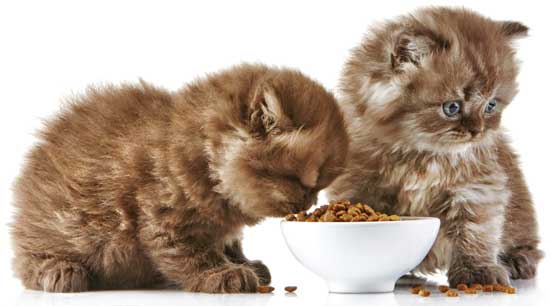 Some plant proteins provide binding and emulsification properties. “Certain pulse proteins, when not processed at high temperatures to denature the protein, have good binding properties that can hold meat and meat-carbohydrate complexes together,” says Lynch. “This can be used to create different extruded shapes, meat chunks, and meat analogues, which can look like the real thing.” Another function of the pulse proteins Lynch notes is that they can also emulsify and bind water and oils to create a homogeneous matrix in mixed composition products. “Egg proteins have been used for these purposes for a number of years, but for some applications, their price point has been pretty high. And they do not seem to offer the emulsification properties.” Best Cooking Pulses, Portage la Prairie, Manitoba, Canada (bestcookingpulses.com), offers a number of pulse ingredients—yellow pea, green pea, chickpea, laird lentil, red lentil, pinto bean, navy bean, and black bean—in flour form not only to boost the protein content of pet food, but to provide important functional properties. Depending on the application (dry, extruded, canned, moist, and chewy), the flour ingredients can help bind fat and water, stabilize emulsions, retain moisture, and replace gums.
Some plant proteins provide binding and emulsification properties. “Certain pulse proteins, when not processed at high temperatures to denature the protein, have good binding properties that can hold meat and meat-carbohydrate complexes together,” says Lynch. “This can be used to create different extruded shapes, meat chunks, and meat analogues, which can look like the real thing.” Another function of the pulse proteins Lynch notes is that they can also emulsify and bind water and oils to create a homogeneous matrix in mixed composition products. “Egg proteins have been used for these purposes for a number of years, but for some applications, their price point has been pretty high. And they do not seem to offer the emulsification properties.” Best Cooking Pulses, Portage la Prairie, Manitoba, Canada (bestcookingpulses.com), offers a number of pulse ingredients—yellow pea, green pea, chickpea, laird lentil, red lentil, pinto bean, navy bean, and black bean—in flour form not only to boost the protein content of pet food, but to provide important functional properties. Depending on the application (dry, extruded, canned, moist, and chewy), the flour ingredients can help bind fat and water, stabilize emulsions, retain moisture, and replace gums.
Another protein alternative is dairy protein, which has specific functions in certain pet food applications. Two ingredient manufacturers exhibiting at the 2015 Petfood & Animal Nutrition show highlighted some key dairy protein ingredients from their portfolios. Whey protein concentrate and whey protein isolate from Milk Specialties Global, Eden Prairie, Minn. (milkspecialtiesglobal.com), are considered high-quality sources of protein and are high in leucine. Whey protein ingredients along with another dairy protein ingredient, milk protein concentrate, are often used in formula products for puppies and kittens to supplement the animals when they are being weaned and for pregnant and lactating mothers. Milk Specialties’ Perki-Lac Powdered Milk Replacer is one such product, and it features the company’s dried whey protein concentrate and dried whey. Both whey protein and milk protein contribute to the amino acid requirements that puppies and kittens have.
Davisco, Eden Prairie, Minn. (daviscofoods.com), promoted the protein-enhancing properties that some of its whey protein ingredients can lend to pet food applications. Two ingredients, BiPRO and BioZate are used to improve muscle health in animals. “Nutritionally speaking, the amino acid profiles of our whey protein isolate BiPRO and our hydrolyzed whey protein BioZate are particularly well-suited for dogs given the similarities in the metabolism of canines and humans and research that has linked leucine content of whey protein to lean body mass and muscle protein synthesis,” says Craig Sherwin, research director at Davisco.
--- PAGE BREAK ---
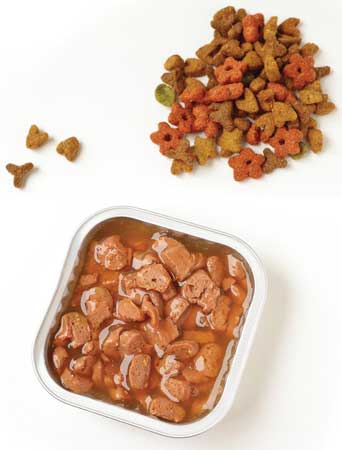 BiPRO is composed of beta-lactoglobulin and alpha-lactalbumin and is high in branched chain amino acids isoleucine, leucine, and valine, while BioZate contains smaller chains of amino acids that are easily digested. “Functionally, Davisco whey proteins come in various forms that can fit into just about any food or treat prototype, including retorted wet food, extruded kibble or semi-moist food, and baked treats,” says Sherwin. To show the functionality of BiPRO, the company distributed samples of a crunchy, bone-shaped dog treat made with the ingredient along with pumpkin, peanut butter, egg, and honey. For other dry applications, there are BioZate 7 and a heat-stable whey protein concentrate, which reduce firm textures and avoid high viscosity doughs during extrusion and baking, adds Sherwin. In wet food, Sherwin explains that the gelation properties of whey protein under heat can bind ingredients and mimic various textures.
BiPRO is composed of beta-lactoglobulin and alpha-lactalbumin and is high in branched chain amino acids isoleucine, leucine, and valine, while BioZate contains smaller chains of amino acids that are easily digested. “Functionally, Davisco whey proteins come in various forms that can fit into just about any food or treat prototype, including retorted wet food, extruded kibble or semi-moist food, and baked treats,” says Sherwin. To show the functionality of BiPRO, the company distributed samples of a crunchy, bone-shaped dog treat made with the ingredient along with pumpkin, peanut butter, egg, and honey. For other dry applications, there are BioZate 7 and a heat-stable whey protein concentrate, which reduce firm textures and avoid high viscosity doughs during extrusion and baking, adds Sherwin. In wet food, Sherwin explains that the gelation properties of whey protein under heat can bind ingredients and mimic various textures.
Turning to Carbohydrates for Added Function
While protein plays an important role in meeting the nutritional needs of cats and dogs (they are descendants of large carnivores after all), so too do carbohydrates. A study published in the journal Nature suggests that domesticated dogs have undergone genetic changes that allow them to adapt to a starch-containing diet as they evolved from ancient wolves (Axelsson et al. 2013).
Carbohydrates from a number of sources—grains, pulses, tubers, fruits, and vegetables—have various uses in pet food products. Even sweeteners like sugar, brown sugar, and more can be found in some pet food and treats where they can mask the bitter flavors of other ingredients or add a particular texture (soft and pliable treats, for example). Louis Dreyfus Commodities, Sugar Land, Texas (ldcom.com), produces molasses syrup and brown sugar, molasses, honey, and maple granules (through its wholly owned subsidiary Imperial Sugar Company) that it promotes for use in pet food and treats.
From a functional standpoint, carbohydrates help to improve binding of ingredients and structural characteristics in baked applications like biscuit treats. They also can help bind ingredients in material that will be extruded or heat treated. In wet food, carbohydrates improve texture and help reduce syneresis. As far as nutrition is concerned, carbohydrates are the most efficient source of energy for cats and dogs, playing roles in blood glucose maintenance, energy storage, and the transport of energy, explained George C. Fahey Jr., professor emeritus at the Dept. of Animal Sciences at the University of Illinois, during a presentation at the 2015 Petfood & Animal Nutrition show (Fahey 2015). Cooking carbohydrates increases their digestibility, he said, as uncooked carbohydrates are often poorly digested by pets.
Fahey mentioned that polysaccharides are the most common types of carbohydrates found in pet food and pet treats as they are considered to be more economical than protein and lipids at supplying dietary energy in pet food. Starch is the largest single type of polysaccharide in pet food, and it is usually provided from grains like wheat, corn, and rice, he added. Potato starch is also used in pet food in products like dry cat and dog food, injection-molded treats, soft moist treats, and canned cat and dog food. Jim Quarles, chief research & development scientist at Ingredion, Westchester, Ill. (ingredion.us), explains that potato starch contributes a number of functions to pet food applications. Some deal with texture and stability, such as potato starch’s high water binding capabilities and good emulsifying properties, he says, while others focus on inherent properties of potato starch, such as its neutral flavor and ability to form clear gels. The overall usage levels of potato starch can be substantially lower than other sources of starch, and potato starch is better at suspending other ingredients at similar levels of use to corn or wheat, adds Quarles.
Some starch may even benefit the gastrointestinal systems of pets. Resistant starch has been shown to lower glycemic response and also increase anaerobic bacterial activity, which results in increased fecal elimination and the possibility of reducing bowel disease, said Fahey.
Fiber also affects digestion. Fiber sources used by pet food manufacturers include gums, grain co-products, beet pulp, pomaces, wood cellulose, peanut hulls, and prebiotic sources. The type of fiber and the amount included in the pet food is important to consider as some types of fiber can interfere with the absorption of nutrients, affect intestinal transit time, and cause digestive problems. While an ideal amount of fiber in the diet has not been established, Fahey said that a diet consisting of 4%–6% supplemental fiber works well. As far as the types of fiber available are concerned, research studies have shown that beet pulp does not significantly affect the digestibility of nutrients when used at moderate levels, explained Fahey. Many food manufacturers formulate pet food with beet pulp—the fibrous material left after sugar is extracted from sugar beets. Mars Petcare includes beet pulp in a patented fiber system in some of its pet food brands to provide energy for cells lining the intestine and to provide bulk to move waste without causing digestive problems like excessive gas or difficulty digesting other nutrients.
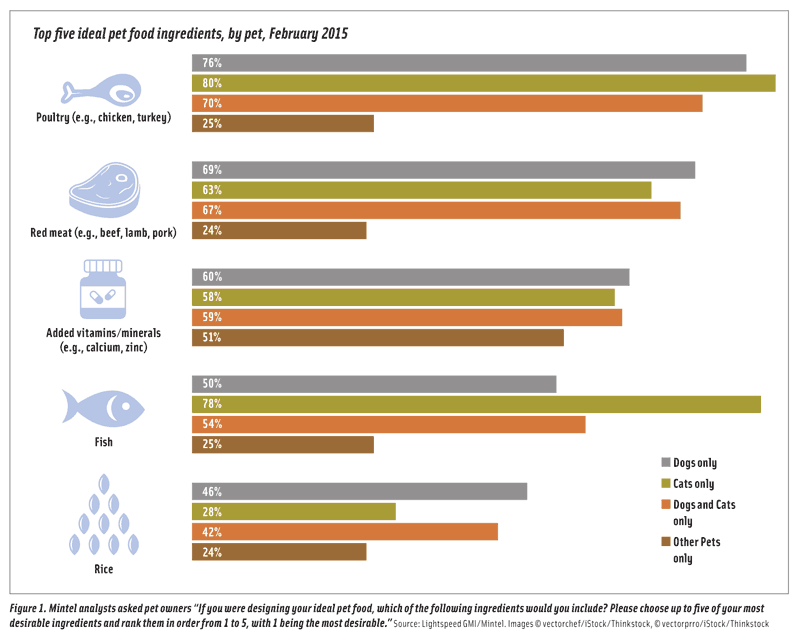
Prebiotic fibers are finding favor among pet food manufacturers. “The interest in prebiotic fibers from manufacturers is very high because just like humans, dogs and cats can have a problem with the bacteria balance in their digestive systems,” says Patrick Luchsinger, marketing manager, nutrition, at Ingredion. He adds that many published peer reviewed studies show that the inclusion of FORTIFEED prebiotic soluble fiber in the diet of dogs and cats can help improve microflora balance; support and maintain a healthy immune and digestive system; reduce unpleasant odors in the stool; and inhibit pathogenic bacteria. The company’s FORTIFEED ingredient is a short-chain fructooligosaccharide prebiotic fiber derived from cane sugar, and it is not digested in the upper gastrointestinal tract. It is made up of beta 2-1 linked linear chains of fructose bound to a terminal glucose. “Because of its special beta-linked structure, FORTIFEED is not affected by digestive enzymes and arrives intact in the intestines where it selectively promotes the growth and activity of beneficial bacteria such as Bifidobacteria and Lactobacilli,” says Luchsinger.
As far as the use of grains in pet food products are concerned, pet food manufacturers include them in products for a number of reasons. Grains are digested into sugars that provide energy, add appealing textures to both wet and dry food and pet treats, and boost the nutritional composition of food by providing vitamins and minerals. Brands like IAMS, produced by Mars Petcare, and Purina, produced by Nestlé Purina PetCare, formulate with grains like corn, barley, and sorghum that are metabolized slowly to provide more maintained energy levels. Whole grains, ancient grains, sprouted grains, and specialty grains add interesting flavors and textures, increase the nutritional profiles, and differentiate products from competitors in bakery products enjoyed by consumers. Increasingly, they may even find some of these grains in pet food. Both Solid Gold Pet and Merrick Pet Care, for example, use brown rice, barley, and oatmeal in some of their pet food.
Ardent Mills, Denver, Colo. (ardentmills.com), which provides bakers and food manufacturers with a comprehensive range of grains, is promoting the potential cross-over appeal of some of these grain ingredients for use in pet food. Organic flour in its specialty grains line and White Spring Whole Wheat Flour in its sprouted flour line can be used in baked biscuit treats. The company produces the ancient grains amaranth, millet, quinoa, sorghum, and teff in both flour and grain form to provide flavor and appearance to different types of pet food products. Finally, Ardent Mills’ Sustagrain, which comes in flour, flake, and chopped forms, is a way to add fiber to certain pet food products.
--- PAGE BREAK ---
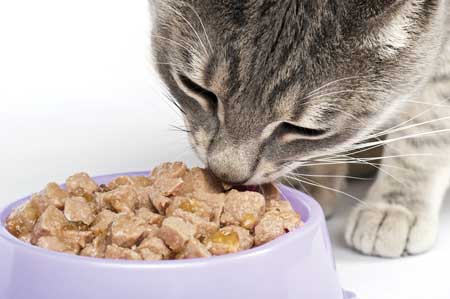 Other Nutrients to Watch
Other Nutrients to Watch
Consumers are looking for food and beverage products that provide them with added benefits that go beyond basic nutrition, and many of these consumers also want the same for their pets. Condition-specific issues are driving sales of pet supplements, with joint health, heart health, and skin/coat on the top of the list, according to A. Elizabeth Sloan, president and CEO at Sloan Trends, Escondido, Calif., who spoke at the 2015 Petfood & Animal Nutrition show (Sloan and Hutt 2015).
Consumers can also find a variety of pet treats and pet foods formulated with ingredients that may benefit dental/oral care, calming/motion sickness, skin/coat, digestive health, renal health, and immune health. These include omega-3 and omega-6 fatty acids, vitamins and minerals, antioxidants, and specialized ingredient systems. Even ingredients like probiotics and digestive enzymes—ones that are popular in products for humans—can easily transfer to the pet food market, said Catherine Adams Hutt, chief science and regulatory officer at Sloan Trends, who spoke along with Sloan.
Several types of ingredients are increasingly used in pet food products to supplement the diet. Three to note here are omega-3 fatty acids, probiotics, and digestive enzymes. Research on omega-3 fatty acids points to numerous health benefits. In Mars Petcare’s IAMS Veterinary Formula Skin & Coat Plus Response LB cat food, omega-3s (as well as omega-6s) are used to promote healthy skin in cats prone to developing itchy skin. The fatty acid can contribute additional benefits to the animal’s health, reports DSM Nutritional Products, Parsippany, N.J. (dsm.com), the manufacturer of DHAgold omega-3 fatty acid. The ingredient may help to reduce inflammation to improve immune and digestive health. The company points to the ingredient’s role in improving mobility in dogs with osteoarthritis and improving glucose control and decreasing plasma insulin concentrations in obese cats. Scientists at the company are even studying how the ingredient affects visual and brain development in puppies.
Docosahexaenoic acid (DHA) omega-3 fatty acid is found throughout the body, and it is derived from many sources such as flaxseed and vegetable oils and fish oils and fish by-products for use in pet food products. DSM’s DHAgold is derived from whole cell Schizochytrium sp. algae through a fermentation process under controlled conditions, which the company says results in a more consistent and sustainable DHA ingredient. The ingredient is in a flake form that is golden brown in color.
As more information is reported about probiotics, consumers are learning about how important these beneficial microorganisms are in maintaining a healthy gut microbiome and digestive system. Probiotics are found in cultured and fermented foods like yogurt and kefir, but they are also formulated into products across many categories such as beverages, bakery, spreads, and confectionery. Even pet food and pet treats include probiotics in the hopes of helping pets avoid digestive complications. VetriScience Laboratories’ GI Balance Pro, Nulo Pet Foods’ MedalSeries food, and H3 Essentials’ Probiotic Treats for Dogs are just a few of the products that feature probiotics. There’s even a seasoning made with probiotics from The Real Meat Company called BioticBoost Pet Food Seasoning. The probiotic source for these particular products mentioned here comes from Ganeden, Mayfield Heights, Ohio (ganedenprobiotics.com). Its GanedenBC30 is a patented strain of probiotic bacteria, Bacillus coagulans GBI-30, 6086. The ingredient, according to the company, can survive through different manufacturing processes, making it a fit for use in extruded kibble and soft baked chews.
Digestive enzymes have different purposes in supporting digestion. In humans with lactose intolerance, the lactase enzyme in Lactaid products helps them digest lactose. Alpha-galactosidase found in Beano breaks down fiber in beans and cruciferous vegetables, minimizing gas and bloat. Cats and dogs, like their humans companions, experience digestive issues when their systems do not produce enough of a particular enzyme naturally or as a result of a health condition. Deerland Enzymes, Kennesaw, Ga. (deerlandenzymes.com), offers a line of enzymes for use in pet food and supplements. Four are used to break down proteins. Acid Protease 3.0 has been shown to reduce feline hairballs, which are more than 90% protein. Bromelain and papain, derived from pineapple and papaya, respectively, are used in both digestive and joint health products where they break down proteins linked with inflammatory response. Peptidase prolyl exopeptidase can help pets digest gluten. The two fat-digesting enzymes the company offers are lipase and pancreatic lipase, with the lipase enzyme providing additional digestive activity in animals on a carnivorous, raw diet. The carbohydrate-digesting enzymes include ones like amylase and glucoamylase, which break down cereal grains and meals in dry pet food, and beta-glucanase, which breaks down beta D-glucans, polysaccharides in barley, wheat, and oats. Xylanase breaks down starches that have xylose-containing polymers. Cellulase, which breaks down cellulose and is not endogenously produced by cats and dogs, is often formulated into pet foods that contain cellulose as a bulking agent or source of fiber.
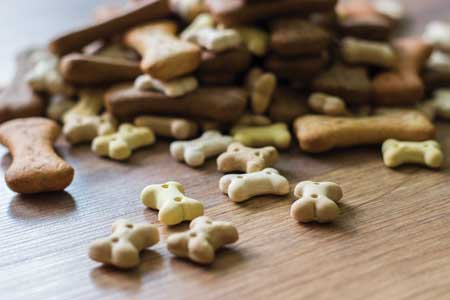 Beyond Kibble and Biscuits
Beyond Kibble and Biscuits
The pet food industry is rife with opportunities for innovation, said Sloan. As pet food product developers brainstorm the next big tasty dog treat or nutritionally complete cat food, they may want to consider some of the suggestions Sloan said offer ways to differentiate products and break into untapped areas in the pet food industry. A few refer to new products themselves. A pet beverage is an interesting concept, and Sloan mentioned that beverages like vitamin waters, exercise recovery drinks, and joint health beverages could appeal to pet owners who want products that may potentially improve the quality of life of their pets. Another area of growth is in weight management and meal replacement products, especially as more pets struggle with overweight and obesity. Finally, Sloan wants pet food manufacturers to “kick the can” and develop foods packaged in pouches (something that appeals to Millennial consumers, who tend to eschew canned foods in favor of foods in pouches, bags, and other packaging, she said).
--- PAGE BREAK ---
Mintel analysts offer their own take on some categories in the pet food sector that are open to innovation. One is seasonal and limited-edition products. While still a niche category (Mintel reports that seasonal product introductions grew from less than 1% in 2010 to close to 2% in 2013), seasonal and limited-edition products are ways for manufacturers to differentiate and appeal to consumers looking to spoil their pets with special treats and foods (Mintel 2016). Seasonal products use ingredients to link the product to a particular holiday or season and can take inspiration from Christmas stockings and Easter eggs. Examples that Mintel points to include Blue Buffalo’s Blue Santa Snacks in oatmeal and cinnamon and Red, White & Blue Stew Summertime Feast with beef BBQ and vegetables; Matina’s Cosma Snackies Advent Calendar for Cats with different flavored snacks for each day of the calendar; and Petco’s Heart-shaped Classic Rawhide dog chews that have “I woof you” printed on the chews. Other manufacturers offer pet food in flavors of the season.
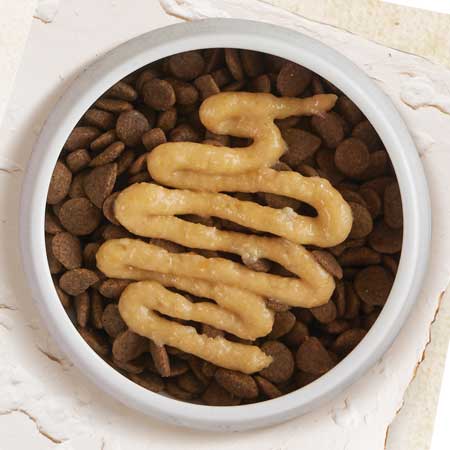 Another emerging product category that Mintel points out includes products that allow pet owners to customize their pet’s food. Toppings, sauces, and mix-ins are a way to add flavors and textures to pet food, and in some cases, nutrients. Purina Felix Sensations Fishy Recipes, sold in several European countries, contains packets of wet cat food and a packet of crunchy pieces to be sprinkled on top of the cat food. In the United States, Nestlé Purina PetCare offers Beyond Natural Puree Mix In Meal Enhancement for Adult Dogs. These products come in formulations that target the immune system or digestive system and are designed to be mixed into the dog’s regular food.
Another emerging product category that Mintel points out includes products that allow pet owners to customize their pet’s food. Toppings, sauces, and mix-ins are a way to add flavors and textures to pet food, and in some cases, nutrients. Purina Felix Sensations Fishy Recipes, sold in several European countries, contains packets of wet cat food and a packet of crunchy pieces to be sprinkled on top of the cat food. In the United States, Nestlé Purina PetCare offers Beyond Natural Puree Mix In Meal Enhancement for Adult Dogs. These products come in formulations that target the immune system or digestive system and are designed to be mixed into the dog’s regular food.
A final point to consider is something that Sloan asked: Why is pet food placed only in the pet food aisle? How about taking a cue from confectionery companies, snack food manufacturers, and other nonfood producers and positioning single-serve, on-the-go pet treats near the registers to grab the attention of impulse buyers. “We’re missing the impulse buy,” said Sloan, who added that some pet owners may not be able to resist that single-serve bag of dog treats at the register, especially if the price is right. Also, consider integrating pet food products throughout drug stores and convenience stores to get attention. More and more drug stores are dispensing prescriptions for drugs for cats and dogs so why not carry pet food products, Sloan proposed. All are interesting ideas to consider in your pet food product development efforts.
Next month’s Ingredients section will feature ingredients used to formulate ice cream.
Give the Owners What They Want
Pet owners are demanding that the food they feed to their pets meets the same food standards as their own food in what market research firm Mintel calls “pet food humanization.” In a report on the U.S. pet food market, Mintel analysts note that human food trends will continue to drive innovation in pet food development, and flavor, ingredients, and nutrition will drive revenue (Mintel 2015). As consumers scrutinize food labels (for human food) and are becoming more aware of the ingredients used, so too are pet owners. The Mintel research found that 55% of pet owners surveyed are concerned about the amount of filler ingredients such as grains and meat by-products in pet food. Almost as many pet owners (49%) agreed with the statement “The best diet for my pet is what they would have eaten in the wild (e.g. all meat, grain-free, no artificial ingredients, etc.).” The analysts report that interest in these types of products may be driven by interest that consumers have in natural food for themselves.
When Mintel asked pet owners to choose their ideal ingredients in pet food, 76% of dog owners and 80% of cat owners chose poultry (Figure 1). It probably comes as no surprise that fish was almost as popular as poultry among cat owners, with 78% choosing this ingredient. Rice was the only grain to crack the top five, and it was favored more by dog owners (46%) than cat owners (28%). Overall, 23% of pet owners chose wheat and 18% chose corn as ideal ingredients.
 Karen Nachay,
Karen Nachay,
Senior Associate Editor
[email protected]
References
Axelsson, E., A. Ratnakumar, M.-L. Arendt, et al. 2013. “The Genomic Signature of Dog Domestication Reveals Adaption to a Starch-rich Diet.” Nature 495: 360–364.
Fahey Jr., G. C., and M. R. C. de Godoy. 2015. “Traditional and Novel Carbohydrate Sources for Pets.” Seminar presented at Petfood & Animal Nutrition 2.0, Chicago, Oct. 20–21.
Mintel. 2015. Pet Food—U.S. May. Mintel, Chicago. mintel.com.
Mintel. 2016. Pet Food Global Annual Review 2016. Mintel.
Sloan, A. E., and C. A. Hutt. 2015. “Pet Health—How Going to the Dogs Can Drive Business Success.” Seminar presented at Petfood & Animal Nutrition 2.0, Chicago, Oct. 20–21.
